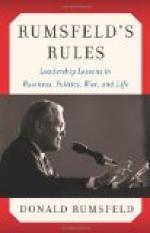To break the centre of an enemy’s line, to pour your forces into and through the gap, and then roll up the more important of his divided wings, is an operation which if it can be successfully executed makes a decisive victory; if followed up it ruins the enemy’s army. But it is in modern conditions the most difficult form of attack. The long range of modern weapons, of guns that kill at two miles and of rifles that kill at a mile—to take a moderate estimate of their power—enables the defender to concentrate upon any attack against his centre the fire of all the rifles in his front line for a couple of miles, and of all the guns standing on a length of four miles. A similar concentration of fire is only occasionally and temporary possible for the assailant, though if it should happen that the ground exposes a point of the defender’s line to such concentric fire, while it protects some points held by the assailant, the attack would have a prospect of success. But the moment the point of attack is recognised by the defender he will collect every available battery and rifleman from all parts of his line and place them on that portion of his front which commands the path of the assailant. To prevent this the assailant must engage the defender along his whole line so that all the defending forces are fully occupied and there are none to spare for the critical point or region.
Sir Redvers Buller’s task is rendered harder by the fact that his own troops before they can attack must cross the Tugela. He has two bridges at the point here supposed to have been selected for the main attack, but troops can hardly cross a bridge at a quicker rate than a brigade an hour, and as the Boers ride faster than the British infantry can walk, and as the British troops south of the river cannot effectually engage the Boers, it will not have been easy so to occupy the enemy along the whole front as to prevent his massing guns and rifles—at any rate rifles—to defend his centre.
So much for the initial difficulties, which seem by a combination of feint and surprise to have been so far overcome on Monday that the advanced British troops effected a lodgment in the centre of the Boer position, from which a counter-attack failed to eject them. The next thing is, as the British force is brought across the river, to attack one of the Boer wings while containing or keeping back the other. Before this, can be done the enemy’s centre must really be pierced, so that troops can be poured through the gap to turn the flank of one of the enemy’s divided halves. This piercing is most difficult in the conditions of to-day, for the enemy by establishing a new firing line behind the point carried by our troops may be able to enclose in a semicircle of fire the party that has made its way into the position. Against such an enveloping fire it is a hard task to make headway.




